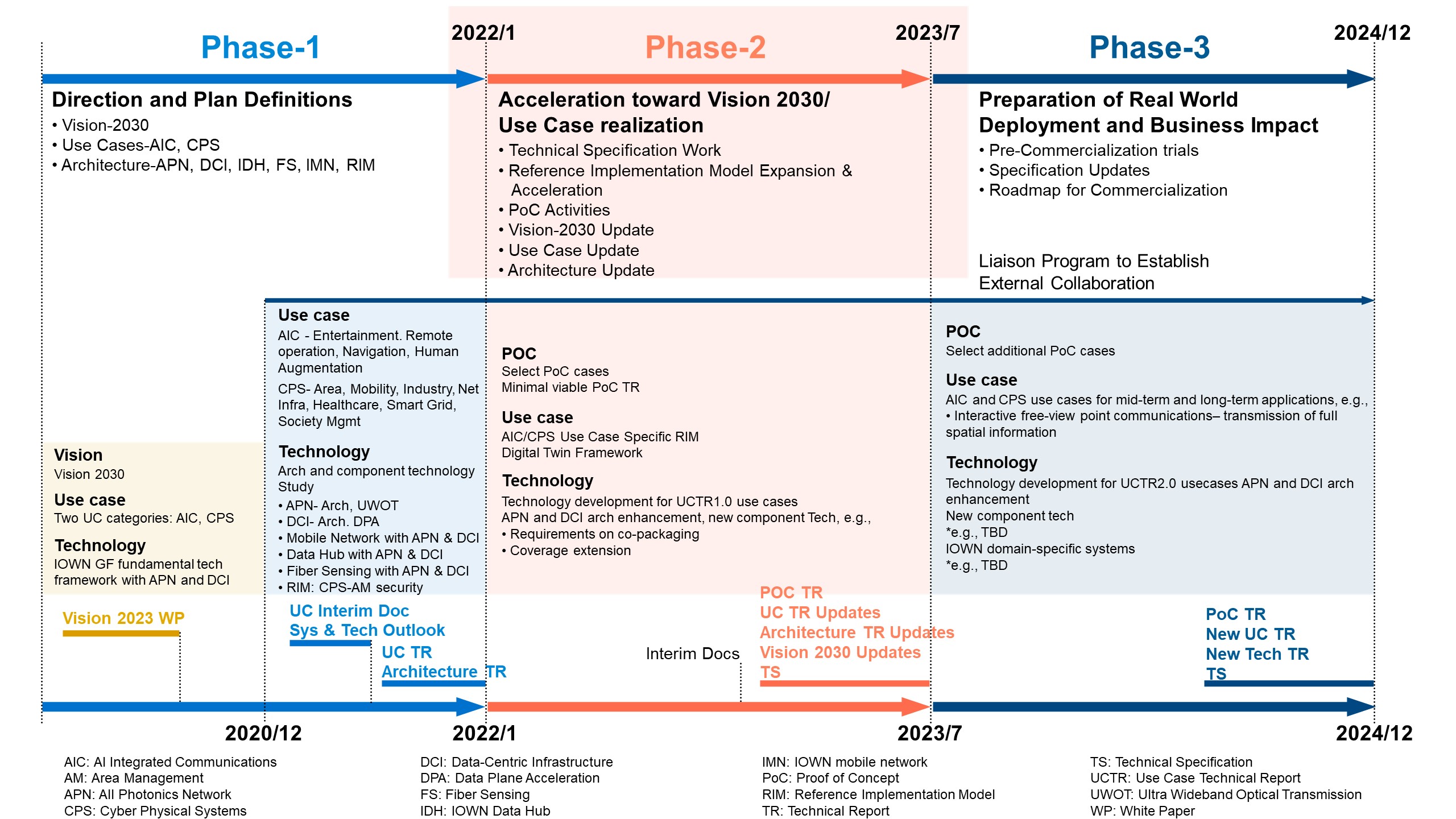In April 2020, IOWN GF published its Vision 2030 white paper, which laid out key technology directions for infrastructure evolution in four dimensions: cognitive capacity, responsiveness, scalability, and energy efficiency. Following up on Vision 2030, IOWN GF started its Phase 1 work to identify use cases and requirements and develop technology solutions.
Many organizations resonated with Vision 2030 and joined the forum. As a result, the number of memberships grew to 85 by the end of 2021. In 2021, IOWN GF completed its Phase 1 work with the following deliverables:
Use Case Reference Documents/Technical Reports:
- Cyber-Physical Systems(CPS) Use Cases Release 1.0: A set of Beyond-Human use cases enabling simulation, prediction and autonomy capabilities for sustainable growth across multiple industries.
- AI Integrated Communication(AIC) Use Cases Release 1.0: A set of human-centric use cases influencing how we perceive the real word and our daily life-style of the future.
Technology Reference Documents/Technical Reports:
- Open All Photonics Network (APN) Functional Architecture: The network infrastructure architecture that creates optical wavelength paths among communication endpoints and enables end-to-end communication with deterministic performance.
- Data-Centric Infrastructure (DCI) Functional Architecture: The architecture of computing infrastructure that enables service providers with the tools needed to build and flexibly place data pipelines, including data processing and storage functions, while dynamically selecting data transfer and network protocols on a pipe-by-pipe basis.
- Data Hub Functional Architecture: The high-speed distributed data management infrastructure architecture leverages Open APN and DCI. It supports APIs that are functionally compatible with well-adopted services, such as Apache Kafka/Pulsar, AWS S3, and SQL.
- Fiber Sensing for Open APN: The system architectures and the use cases for applying the fiber sensing function to the IOWN Open APN.
- Technology Outlook for Mobile Networks using IOWN Technology: New requirements and proposed solutions and evolution paths for the transport networks to support next-generation wireless networks utilizing IOWN technologies.
- Reference Implementation Model for the Area Management Security Use Case: The reference implementation model of an end-to-end system that will meet the IOWN Global Forum Area Management Security requirements, which is one use case in the CPS Use Case category.
Moving forward, IOWN GF will start its Phase 2, which will include various engaging activities as follows:

First, we will enhance key technical architectures/concepts defined in the aforementioned deliverables, developing reference implementation models and necessary technical specifications. In particular, although IOWN GF’s vision is targeted for 2030, it would be hard to develop technologies that are truly viable and practically operable only through documentation activities.Considering that, IOWN GF plan to develop PoC specifications or reference technical documents and we will encourage members to implement PoC. Through an iterative process, IOWN GF will update our architectures and technologies based on the results of PoC/technical evaluation by members when needed. This will eventually lead service providers and product suppliers to share a clearer view of how IOWN GF’s technical concepts, such as Open APN, DCI, and Data Hub, are implemented.
Second, we will develop reference implementation models for the defined use cases. Many of the use cases were developed through proposals from memberships representing the adopter side of computing and network technologies. Developing reference implementation models for these use cases will help the proponents implement the use cases with IOWN technologies. This will also help IOWN service providers and product suppliers recognize the user demands more accurately. Moreover, we will start developing digital twin computing frameworks to enable digital twin applications across industrial domains.
Third, we will start several new work items for the envisioned quantum leaps. Open APN, DCI, and Data Hub are designed to be evolvable with the progress of optical/radio communication and photonic-electronic convergence (PEC) technologies. New work items, including use cases and technologies, should embrace the progress of these technologies. Use cases such as real-time volumetric capturing and technical work items such as in-home APN and co-packaged optics for DCI are currently being reviewed as possible new work items.
Last but not least, we will continue to build liaison relationships to other fora and SDOs to align and complement the various aspects of our respective work for an efficient and effective advance of the industry and its standardization efforts.
We are excited to embark on a long-term evolution journey toward Vision 2030 with members and partnering organizations.
Read the April 11, 2022 Press Release.


